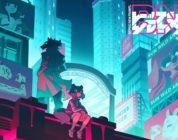For the first time in fifteen years, the elite cyborg law enforcement group Section 9 returns to our television screens. Netflix brings us the new anime series, Ghost in the Shell: SAC_2045. Featuring new CGI animation from Production I.G, this series continues from where Ghost in the Shell: 2nd Gig left off. Better yet, the shows’ original voice cast triumphantly returns. Shinji Amaki and Kenji Kamiyama direct this ambitious new entry and fill it with solid action sequences and moving moments. One can only hope, though, that the second season will make up for some of the questionable artistic choices.
Background
The year is 2045, and the future looks bleak. Some time earlier, the devastating Simultaneous Global Default occurred. This default ruined the entire global economy, rendering all currency useless. The “Big 4” agree to a sustainable war as a means of keeping the economy going. Section 9, after a long stretch spent disbanded, reunites as a group of mercenaries, earning their pay by battling in hotspots around the world. Their living is soon interrupted as a far more dire threat emerges, one that can become an immeasurable threat to humanity.
Reprised Cast
Seeing The Major, Batou, Togusa, Monkey Man, and the rest of the gang is a welcome sight for long-time fans. It’s heartwarming to hear the voices of Richard Epcar, Mary Elizabeth McGlynn and the rest of the crew from Ghost In The Shell: 2nd Gig. For me, it feels like the team never left and reminds me of all those times I stayed up watching the show on Toonami until 2:30am on Saturday nights. The chemistry amongst the cast is as strong as ever before. Mary Elizabeth McGlynn continues her no-nonsense, rational demeanor as The Major. Determined to pursue justice, but remain observant and methodical, she relies on her teammates’ strengths to get out of the toughest situations. Richard Epcar, voicing Batou, is incredibly strong as well and clearly has fun playing the tough-as-nails, yet surprisingly human Batou.
The Artistry
Ghost in the Shell: SAC_2045 is incredibly entertaining as well. Although it is computer-animated, at times it feels more like a moving graphic novel. The character models are as sharp as ever in their CGI forms while the design allows for larger scaled, high stakes action. From fighting a giant exosuit to chasing a spider tank, there are plenty of thrills in store for anyone seeking exciting dystopic action.
When things settle down, the acting and story are clear, and, toward the second half of the first season, the plot’s mystery deepens. The story of the “post-humans” greatly expands upon the lore of Ghost In The Shell, accentuating the dilemmas around humans merging with cybernetic technologies. The pacing is charged and keeps viewers hooked and guessing at what will happen next. There’s much more action here than in previous entries in the Ghost In The Shell line, but it does make more entertaining moments.
 Drawbacks
Drawbacks
Regrettably, despite the solid action moments, intrigue, and expansion of the lore, the first half of the season stumbles significantly. The first error appears with the character known as Standard (Keith Silverstein). Standard is a newer member of the team, but the way he is written and portrayed feels rather misguided and unnatural. Initially, he provides comedic relief to the team during the more action-oriented moments, but his dialogue and role in the show feel stereotypical.
It’s possible that, in writing out the overall story for Ghost in the Shell: SAC_2045, the writers were conflicted. They knew that the show would be broadcasted to a larger, global audience, now that anime has hit the mainstream. Having the heavier, more intellectual themes of Ghost In The Shell might discourage this wider audience. Perhaps they wanted to create a newer, more relatable character, one that casual viewers would easily grasp.
Still, Standard could have been written better and given a larger role for the first half of the season. This was an opportunity to create a new character for a new generation of Ghost In The Shell fans. One frustrating moment in particular has Standard effectively written out of a massive firefight. At the halfway point of the first Season, Standard effectively disappears from the rest of the story. He isn’t killed, and it’s certainly possible he’ll return in the second season, but I feel he should have been given a better role and more agency.
Where The Story Falls Short
Further detracting from the series is how the overall story stumbles in the first half of the season. The premise that Section 9 became mercenaries quickly disappears. This was a missed opportunity. Instead, the show rushed to get to the main plot, which ended on a cliffhanger anyhow. Most of the season skips out on the deep, philosophical themes that the series is known for. Issues of consciousness, the soul, transcendence, cybernetic technologies, and the very nature of humans and their interfacing with computer systems are what Ghost In The Shell is known for. The first half of Season 1 is devoid of this.
While there appears to be some kind of theme developing in the second half, the cliffhanger ending aborts that progress. There is a sensation that a relevant, intellectual theme is forming and will be the focus of Season 2. Regardless, it is disappointing that this wasn’t fleshed out better in Season 1.
Once again, it’s likely that the writers went this direction to appeal to a wider audience. When the original series aired, anime was still a niche medium outside of Japan. Toonami was just about the only place to absorb new anime and the show aired at unreasonably late hours. Anime enthusiasts might have no problem staying up and dissecting the consequences of merging man and machine, but that was over twenty years ago.
The range and scope of anime has drastically changed since then, becoming a global phenomenon. I can imagine the struggle in the writers’ room. They surely wanted to keep the series attuned to its predecessors’ themes while introducing a fascinating new cyberpunk world to the masses. It isn’t an easy task, trying to maintain a thought provoking plot while including more action. To that end, Ghost in the Shell: SAC_2045 did a good enough job to make me curious about Season Two. The overall execution could have been far worse.
All Told
Ultimately, despite its shortcomings, Ghost in the Shell: SAC_2045 is well worth your time. This is in many ways the Ghost In The Shell that you grew up with, just with a different perspective and presentation. The great English voice cast returns for another intriguing mission in the dystopic cyberpunk world, and while there were some mishaps with this first season, I am on board for whatever comes next.
Ghost in the Shell: SAC_2045 is now streaming on Netflix.





